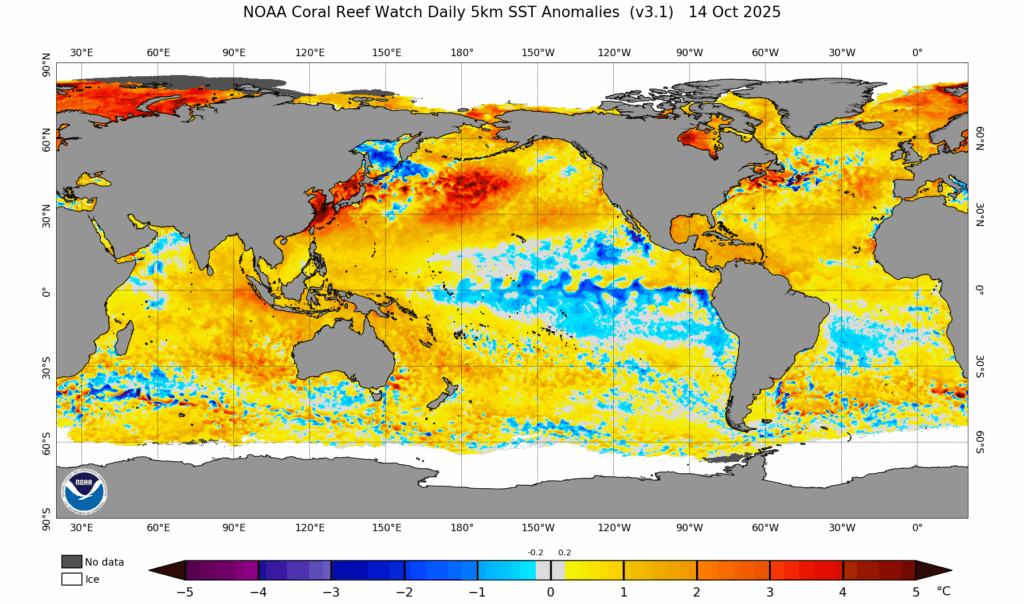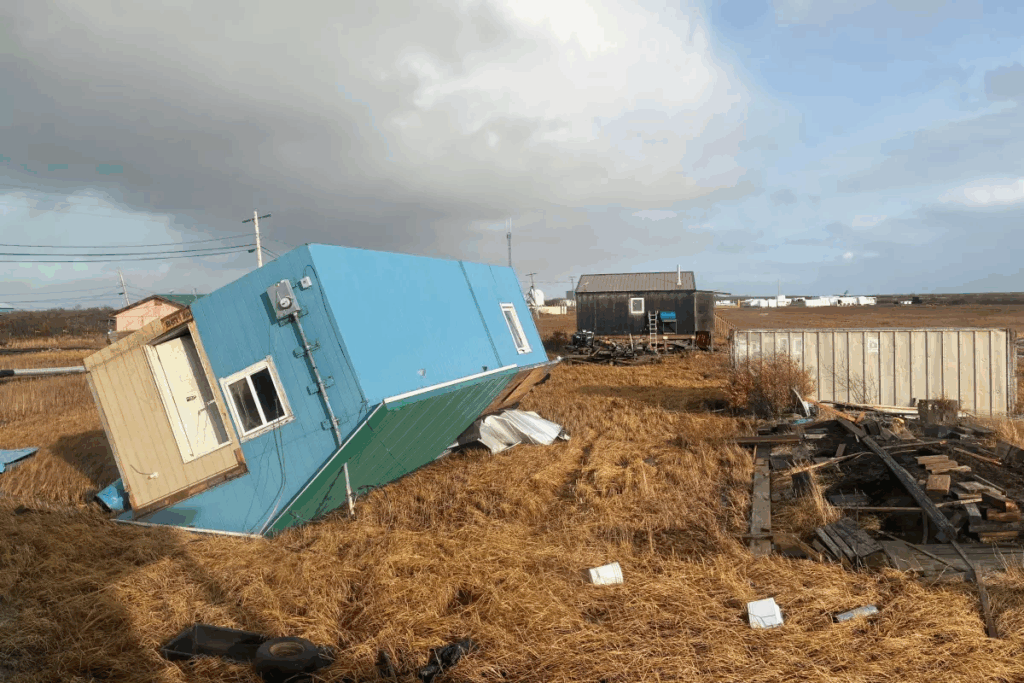The main purpose of this ongoing blog will be to track planetary extreme, or record temperatures related to climate change. Any reports I see of ETs will be listed below the main topic of the day. I’ll refer to extreme or record temperatures as ETs (not extraterrestrials).😜
Main Topic: Warm Pacific Waters Exacerbate Violent Alaskan Storms
Dear Diary. As I keep stating, the United States has been fortunate not to have experienced a direct landfall from a major hurricane or have a devastating wildfire such as the Palisades Fire over the summer and early fall. However, the state of Alaska has been plagued with October storms that I know we’re exacerbated by warmer than average Pacific waters.

The remnants of Typhoon Halong were energized by warm waters stretching from Japan to Alaska that devastated two Alaska villages, displacing more than 1,500 people and killing at least one with two missing. This destruction would be the equivalent of a CAT1 hurricane making landfall along the Gulf Coast.
Here are more details from the Los Angeles Times:
Alaska storms drive 1,500 from their homes and 2 villages are decimated – Los Angeles Times
Alaska storms drive 1,500 from their homes and 2 villages are decimated

An unoccupied home rests on its roof after being knocked over in Kotlik, Alaska, Sunday, Oct. 12, 2025, after the remnants of Typhoon Halong hit western Alaska. (Adaline Pete / Associated Press)
By Becky Bohrer, Cedar Attanasio and Gene Johnson
Oct. 15, 2025 10:38 AM PT
- The remnants of Typhoon Halong devastated two Alaska villages, displacing more than 1,500 people and killing at least one with two missing.
- Homes in Kipnuk and Kwigillingok floated out to sea as the Coast Guard rescued two dozen people from drifting structures during catastrophic flooding.
- Hundreds shelter in schools, some without working toilets, as officials evacuate residents before winter arrives in the remote communities.
JUNEAU, Alaska — Rain and wind were forecast Wednesday along the Alaska coast where two villages were devastated by the remnants of Typhoon Halong and officials were scrambling to find shelter for more than 1,500 people driven from their homes.
The weekend storm brought high winds and storm surges that battered the low-lying Alaska Native communities along the Yukon-Kuskokwim Delta in the southwest part of the state, nearly 500 miles from Anchorage. At least one person was killed and two were missing. The Coast Guard plucked two dozen people from their homes after the structures floated out to sea.
Hundreds were staying in school shelters, including one with no working toilets, officials said. The weather system followed a storm that struck parts of western Alaska.
Across the region, more than 1,500 people were displaced by the back-to-back storms. Dozens were flown to a shelter set up in the National Guard armory in the regional hub city of Bethel, a community of 6,000 people, and officials were considering flying evacuees to longer-term shelter or emergency housing in Fairbanks and Anchorage.
The hardest-hit communities included Kipnuk, population 715, and Kwigillingok, population 380. They are off the state’s main road system and reachable this time of year only by water or air.
“It’s catastrophic in Kipnuk. Let’s not paint any other picture,” Mark Roberts, incident commander with the state emergency management division, told a news conference Tuesday. “We are doing everything we can to continue to support that community, but it is as bad as you can think.”
Heartbreaking moment
Among those awaiting evacuation to Bethel on Tuesday was Brea Paul, of Kipnuk, who said in a text message that she had seen about 20 homes floating away through the moonlight on Saturday night.
“Some houses would blink their phone lights at us like they were asking for help but we couldn’t even do anything,” she wrote.
The following morning, she recorded video of a house submerged nearly to its roofline as it floated past her home.
Paul and her neighbors had a long meeting in the local school gym on Monday night. They sang songs as they tried to figure out what to do next, she said. Paul wasn’t sure where she would go.
“It’s so heartbreaking saying goodbye to our community members not knowing when we’d get to see each other,” she said.
About 30 miles away in Kwigillingok, one woman was found dead and authorities on Monday night called off the search for two men whose home floated away.
The school was the only facility in town with full power, but it had no working toilet and 400 people stayed there Monday night. A situation report from the state emergency operations center on Tuesday noted that portable toilets, or “honey buckets,” were being used.
A preliminary assessment showed every home in the village was damaged, with about three dozen having drifted from their foundations, the emergency management office said.
Power systems flooded in Napakiak, and severe erosion was reported in Toksook Bay. In Nightmute, officials said fuel drums were reported floating in the community, and there was a scent of fuel in the air and a sheen on the water.
The National Guard was activated to help with the emergency response, and crews were trying to take advantage of any breaks in the weather to fly in food, water, generators and communication equipment.
Long road to recovery ahead, officials say
Officials warned of a long road to recovery and a need for continued support for the hardest-hit communities. Most rebuilding supplies would have to be transported in and there is little time left before winter.
“Indigenous communities in Alaska are resilient,” said Rick Thoman, an Alaska climate specialist at the University of Alaska Fairbanks. “But, you know, when you have an entire community where effectively every house is damaged and many of them will be uninhabitable with winter knocking at the door now, there’s only so much that any individual or any small community can do.”
Thoman said the storm was likely fueled by the warm surface waters of the Pacific Ocean, which has been heating up because of human-caused climate change and making storms more intense.
Three years ago, the remnants of another storm, Typhoon Merbok, caused damage across a massive swath of western Alaska.
Bohrer, Attanasio and Johnson write for the Associated Press. Johnson and Attanasio reported from Seattle.
More to Read

- Dozens rescued as remnants of typhoon hit Alaska while nor’easter brings flooding to East Coast
- Oct. 13, 2025
More:
Here are more “ETs” recorded from around the planet the last couple of days, their consequences, and some extreme temperature outlooks, as well as any extreme precipitation reports:
Here is More Climate News from Wednesday:
(As usual, this will be a fluid post in which more information gets added during the day as it crosses my radar, crediting all who have put it on-line. Items will be archived on this site for posterity. In most instances click on the pictures of each tweet to see each article. The most noteworthy items will be listed first.)